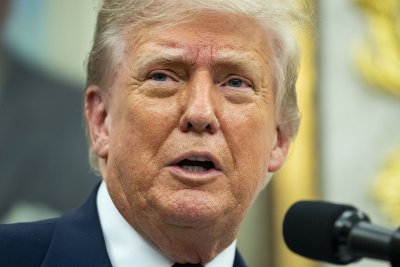
Aug. 7 (UPI) — President Donald Trump‘s sweeping new tariffs on dozens of nations went into effect early Thursday following months of delays and threats from the American leader.
“IT”S MIDNIGHT!!! BILLIONS OF DOLLARS IN TARIFFS ARE NOW LOWING INTO THE UNITED STATES OF AMERICA,” Trump said on his Truth Social platform announcing the levies were now in effect.
The American president has long relied on tariffs as a punishment, a negotiating tool and a measure to right what he views as negative trade imbalances that the United States has with other countries.
He has described these deficits as an “unusual and extraordinary threat” to the United States’ national security and economy.
Under the executive order he signed last week, most countries’ imports to the United States will be subjected to a baseline 10% tariff, which went into effect at midnight Wednesday. Other governments, such as South Korea, the European Union, Britain and Japan, will have more complicated and different tariff rates as they rushed to make deals with the Trump administration ahead of last month’s deadline.
Brazil, for instance is facing a total 50% tariff after Trump slapped a 40% levy against it over the prosecution of his ally, former far-right President Jair Bolsonaro.
He also raised tariffs to 50% on India on Wednesday over the country’s continued purchase of Russian oil.
Canada, the United States’ closest partner, was hit with a 35% tariff, up from 25%.
On Wednesday, Trump also announced he would be imposing a 100% tariff on semiconductor chips.
According to the nonpartisan Yale Budget Lab think tank, U.S. consumers will face an overall average effective tariff rate of 17.3% — the highest since 1935, during the Great Depression.
The think tanks states that the average per-household income loss will be $2,400 this year. Textiles and clothing will be disproportionally affected by the tariffs, with consumers expected to face 40% higher costs for shoes and 38% higher prices for apparel.
Meanwhile, the nonpartisan Tax Foundation states that Trump’s tariffs could raise $2.1 trillion in revenue over the next 10 years, but will reduce total revenue raised by $1.6 trillion and reduce GDP by 0.8%.
Despite what analysts say, the Trump administration has been bullish on the tariffs, saying they will generate billions for the United States.
During a press conference at the White House with Apple CEO Tim Cook on Wednesday, Trump said, “I think we’ll be taking in hundreds of billions of dollars in tariffs.”
“We have a great country. We have a country that is going to be very rich. It’s a country that we’re very proud of, but it’s going to be very rich,” Trump said.
Trump initially announced the so-called reciprocal tariffs in April but then paused them for all countries but China for 90 days to allow time for the governments to hash out deals with the United States. In July, he delayed them again until Aug. 1. Then a day before the tariffs were to go into effect, he pushed their deadline a week.
